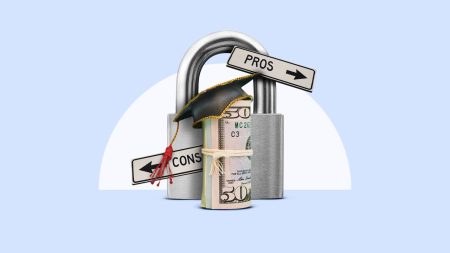Hill Street Studios/Getty Images
Key takeaways
- Tariff uncertainty may delay Federal Reserve rate cuts, as the tariff deadline has been moved to Aug. 1.
- High-yield savings accounts remain a smart move, with leading yields surpassing 4 percent APY.
- If the Fed cuts rates later this year, so too might today’s high APYs disappear, making now the time to act before deposit yields fall.
Consumers aren’t the only ones feeling tariff whiplash as the Federal Reserve is likely reeling from the announcement of yet another delay, prolonging speculation about the impact of tariffs on the U.S. economy.
Although President Donald Trump first announced tariffs on April 2 — the so-called “Liberation Day” — tariffs are, once again, on hold, moving the deadline from July 9 to Aug. 1. This means that Trump’s reciprocal tariffs are set to take effect after the Fed’s July meeting, increasing the likelihood that the central bank will hold interest rates steady as it waits for economic data about the impact of Trump’s economic policy.
Here’s what this means for high-yield savings accounts (HYSAs) and a current look at the best rates on the market this week.
Today’s best savings account rates
The top-notch yield remains with Peak Bank, the online division of First Idaho Bank, offering a 4.44 percent annual percentage yield (APY) on new savings accounts. Peak Bank isn’t currency monitored by Bankrate’s editorial team, but the list below shows the top APYs for those we do.
Of the banks and credit unions monitored in Bankrate’s best high-yield savings accounts list, the top yield of 4.30 percent remains to be offered by a handful of banks.
Note: Annual percentage yields (APYs) are as of July 14, 2025. APYs for some products may vary by region.
The latest news from the Federal Reserve
The Federal Reserve was poised to continue lowering rates following its December 2024 meeting, but economic turbulence has led the central bank to remain steadfast on the federal funds rate.
Aside from keeping an eye on inflation and the job market, the primary culprit of economic uncertainty comes from President Trump’s tariffs, which still haven’t taken effect with trade talks still ongoing.
The outlook for inflation that I have — and in accordance with what many private forecasters have — is for inflation to increase going forward, mostly owing to tariffs.
— Alberto Musalem, President | Federal Reserve Bank of St. Louis
While the central bank said in its June meeting that uncertainty has diminished, Fed Chair Jerome Powell has reiterated, time and again, that the central bank will continue monitoring economic data to decide when the time is right to lower interest rates. Thus, because tariffs won’t be in effect until Aug. 1 (at least for now), it’s likely that the Fed will leave interest rates unchanged during its July 30 meeting.
How does the federal funds rate affect savings account APYs?
There’s an indirect relationship between the Fed’s federal funds rate and deposit account APYs. The Fed takes a restrictive policy stance when it raises the federal funds rate. Because this hikes the cost of borrowing money, banks tend to react by increasing deposit yields to attract and retain depositors in an attempt to keep cash within their ecosystem. Read more about the Federal Reserve and its influence on banks and interest rates in Bankrate’s article: How the Federal Reserve impacts savings account interest rates
Benefits of a high-yield savings account in today’s rate environment
In the current rate landscape, HYSAs offer a rare opportunity: low-risk, steady growth at some of the best yields in years. With top accounts offering APYs above 4 percent, your savings can grow significantly faster compared with rock-bottom yields — between 0.01 and 0.1 percent APY — offered at many of the largest institutions.
With the extension of the effective date of President Trump’s tariffs, it’s likely the Federal Reserve will continue to hold rates steady. Thus, with interest rates remaining elevated for now — and potentially for a couple of months to come — there’s still time to take advantage of these high yields before the Fed cuts interest rates further.
A high-yield savings account is great for your emergency fund in any rate environment, but especially now with the top-yielding accounts paying more than the rate of inflation. This better helps preserve your buying power over time, while still offering federal deposit insurance and penalty-free access.
— Greg McBride, CFA | Bankrate Chief Financial Analyst
As always, look beyond just the headline APY. The best savings accounts have no monthly fees, low or no minimum deposits and few (if any) withdrawal limits. And remember that regularly reviewing your account and rate can help you stay on track.
Did you know?
Compound interest is a powerful force for consumers eager to build their savings account, creating a multiplier effect on money in savings that can help it grow faster. Read about the effects of earning interest on interest in Bankrate’s guide: What is compound interest?
You might also consider pairing your HYSA with a certificate of deposit (CD), which, in contrast to HYSAs, provides a fixed interest rate for the duration of the account’s term.
Bottom line
Ongoing delays in tariff implementation are creating economic uncertainty — and giving savers more time to capitalize on elevated deposit rates. With APYs above 4 percent still available and the Fed holding the federal funds rate steady, now is a window of opportunity to boost your savings with minimal risk.
Why we ask for feedback
Your feedback helps us improve our content and services. It takes less than a minute to
complete.
Your responses are anonymous and will only be used for improving our website.
Help us improve our content
Read the full article here









